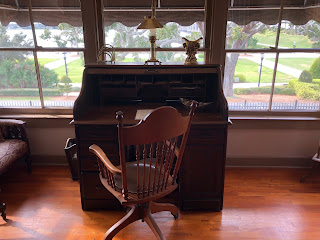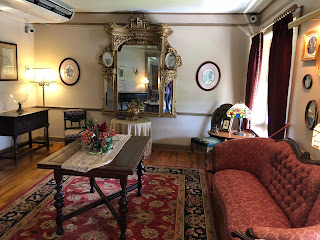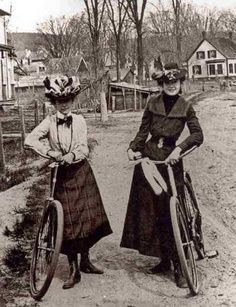I have to admit, once or twice...well, okay, maybe three or four times...I've attended concerts, readings, plays, lectures or other events because I liked the advertisement for it.
Now tell me you wouldn't attend a lecture after seeing a photo like this. Of course, it combines topics as close to my hearts as my Mercians: cycling, history, women's history and gender identity. Tessa Hull, who gave the lecture, didn't come to her topic--summed up in the lecture's title, "Women, Trans and Femme Riders in Early Cycling History"--through a women's or gender studies program. Instead, she encountered it while on her own journey, literally: She's cycled alone from Southern California to Maine and in Alaska, Cuba, Ghana and Mexico. She said that, wherever she went, people were generous, but she heard the same warning: "You know, a woman can't travel alone."
Well, I know that's not true! And so did some women in the late 19th Century, during the first "Bike Boom." Although there probably are more women cycling now than then, she believes that the culture around women and bikes has retrogressed in some ways. In the old bicycle ads, she explains, "you see packs of women riding bicycles, and women riding on the front of tandems," none of which is "really a norm now." She feels we are "trying to get back to where we were in the 1890s " and warns, "[I]f you don't keep pushing for the advancement of culture, things can quietly digress."
I have to admit, even I--who, if I do say so myself, knows a thing or two about the history of women and cycling--was surprised to see women attired as they are in the photo. And they have rather athletic builds. These days, it seems that most women in bike ads are there to entice men and look as if their limbs would break if they actually tried to pedal.
Now tell me you wouldn't attend a lecture after seeing a photo like this. Of course, it combines topics as close to my hearts as my Mercians: cycling, history, women's history and gender identity. Tessa Hull, who gave the lecture, didn't come to her topic--summed up in the lecture's title, "Women, Trans and Femme Riders in Early Cycling History"--through a women's or gender studies program. Instead, she encountered it while on her own journey, literally: She's cycled alone from Southern California to Maine and in Alaska, Cuba, Ghana and Mexico. She said that, wherever she went, people were generous, but she heard the same warning: "You know, a woman can't travel alone."
Well, I know that's not true! And so did some women in the late 19th Century, during the first "Bike Boom." Although there probably are more women cycling now than then, she believes that the culture around women and bikes has retrogressed in some ways. In the old bicycle ads, she explains, "you see packs of women riding bicycles, and women riding on the front of tandems," none of which is "really a norm now." She feels we are "trying to get back to where we were in the 1890s " and warns, "[I]f you don't keep pushing for the advancement of culture, things can quietly digress."
I have to admit, even I--who, if I do say so myself, knows a thing or two about the history of women and cycling--was surprised to see women attired as they are in the photo. And they have rather athletic builds. These days, it seems that most women in bike ads are there to entice men and look as if their limbs would break if they actually tried to pedal.




















